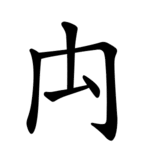| 禸 | ||
|---|---|---|
| ||
| 禸 (U+79B8) "track" | ||
| Pronunciations | ||
| Pinyin: | róu | |
| Bopomofo: | ㄖㄡˊ | |
| Wade–Giles: | jou2 | |
| Cantonese Yale: | yau2 | |
| Jyutping: | jau2 | |
| Japanese Kana: | ジュウ jū (on'yomi) | |
| Sino-Korean: | 유 yu | |
| Names | ||
| Japanese name(s): | 寓の脚/ぐうのあし gūnoashi | |
| Hangul: | 자귀 jagwi | |
| Stroke order animation | ||
 | ||
Radical 114 or radical track (禸部) meaning "rump" or "track" is one of the 23 Kangxi radicals (214 radicals in total) composed of 5 strokes.
In the Kangxi Dictionary, there are 12 characters (out of 49,030) to be found under this radical.
禸 is not listed in the Table of Indexing Chinese Character Components, hence not used as a Simplified Chinese radical (indexing component).
Evolution
 Small seal script character
Small seal script character
Derived characters
| Strokes | Characters |
|---|---|
| +0 | 禸 |
| +4 | 禹 禺 |
| +6 | 离 (also SC form of 離 -> 隹) |
| +7 | 禼 |
| +8 | 禽 |
Variant forms
The radical character as an independent Chinese character takes different forms in different languages.
| Trad. Chinese (Taiwan) | Simp. Chinese | Japanese | Korean |
|---|---|---|---|
| 禸 | 禸 | 禸 | 禸 |
When used as a component, its form depends on not only languages but also characters.
| Trad. Chinese (Taiwan) | Simp. Chinese | Japanese | Korean |
|---|---|---|---|
| 禺 离 | 禺 离 | 禺 离 | 禺 离 |
Literature
- Fazzioli, Edoardo (1987). Chinese calligraphy : from pictograph to ideogram : the history of 214 essential Chinese/Japanese characters. calligraphy by Rebecca Hon Ko. New York: Abbeville Press. ISBN 0-89659-774-1.
- Lunde, Ken (Jan 5, 2009). "Appendix J: Japanese Character Sets" (PDF). CJKV Information Processing: Chinese, Japanese, Korean & Vietnamese Computing (Second ed.). Sebastopol, Calif.: O'Reilly Media. ISBN 978-0-596-51447-1.
External links
Wikimedia Commons has media related to Radical 114.
This article is issued from Wikipedia. The text is licensed under Creative Commons - Attribution - Sharealike. Additional terms may apply for the media files.